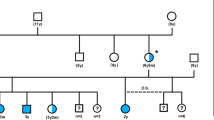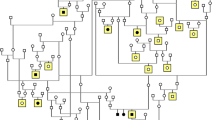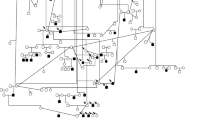Abstract
Canine generalized progressive retinal atrophy (gPRA) is characterized by continuous degeneration of photoreceptor cells leading to night blindness and progressive vision loss. Until now, mutations in 11 genes have been described that account for gPRA in dogs, mostly following an autosomal recessive inheritance mode. Here, we describe a gPRA locus comprising the newly identified gene coiled-coil domain containing 66 (CCDC66) on canine chromosome 20, as identified via linkage analysis in the Schapendoes breed. Mutation screening of the CCDC66 gene revealed a 1-bp insertion in exon 6 leading to a stop codon as the underlying cause of disease. The insertion is present in all affected dogs in the homozygous state as well as in all obligatory mutation carriers in the heterozygous state. The CCDC66 gene is evolutionarily conserved in different vertebrate species and exhibits a complex pattern of differential RNA splicing resulting in various isoforms in the retina. Immunohistochemically, CCDC66 protein is detected mainly in the inner segments of photoreceptors in mouse, dog, and man. The affected Schapendoes retina lacks CCDC66 protein. Thus this natural canine model for gPRA yields superior potential to understand functional implications of this newly identified protein including its physiology, and it opens new perspectives for analyzing different aspects of the general pathophysiology of gPRA.





Similar content being viewed by others
References
Petersen-Jones S (2005) Advances in the molecular understanding of canine retinal diseases. J Small Anim Pract 46:371–380
Dekomien G, Runte M, Godde R, Epplen JT (2000) Generalized progressive retinal atrophy of Sloughi dogs is due to an 8-bp insertion in exon 21 of the PDE6B gene. Cytogenet Cell Genet 90:261–267
Goldstein O, Zangerl B, Pearce-Kelling S, Sidjanin DJ, Kijas JW, Felix J et al (2006) Linkage disequilibrium mapping in domestic dog breeds narrows the progressive rod-cone degeneration interval and identifies ancestral disease-transmitting chromosome. Genomics 88:541–550
Mellersh CS, Boursnell ME, Pettitt L, Ryder EJ, Holmes NG, Grafham D et al (2006) Canine RPGRIP1 mutation establishes cone-rod dystrophy in miniature longhaired dachshunds as a homologue of human Leber congenital amaurosis. Genomics 88:293–301
Petersen-Jones SM, Entz DD, Sargan DR (1999) cGMP phosphodiesterase-alpha mutation causes progressive retinal atrophy in the Cardigan Welsh corgi dog. Invest Ophthalmol Vis Sci 40:1637–1644
Suber ML, Pittler SJ, Qin N, Wright GC, Holcombe V, Lee RH et al (1993) Irish setter dogs affected with rod/cone dysplasia contain a nonsense mutation in the rod cGMP phosphodiesterase beta-subunit gene. Proc Natl Acad Sci U S A 90:3968–3972
Zangerl B, Goldstein O, Philp AR, Lindauer SJ, Pearce-Kelling SE, Mullins RF et al (2006) Identical mutation in a novel retinal gene causes progressive rod-cone degeneration in dogs and retinitis pigmentosa in humans. Genomics 88:551–563
Zhang Q, Acland GM, Parshall CJ, Haskell J, Ray K, Aguirre GD (1998) Characterization of canine photoreceptor phosducin cDNA and identification of a sequence variant in dogs with photoreceptor dysplasia. Gene 215:231–239
Lippmann T, Jonkisz A, Dobosz T, Petrasch-Parwez E, Epplen JT, Dekomien G (2007) Haplotype-defined linkage region for gPRA in Schapendoes dogs. Mol Vis 13:174–180
Lippmann T, Pasternack SM, Kraczyk B, Dudek SE, Dekomien G (2006) Indirect exclusion of four candidate genes for generalized progressive retinal atrophy in several breeds of dogs. J Negat Results Biomed 5:19
Miller SA, Dykes DD, Polesky HF (1988) A simple salting out procedure for extracting DNA from human nucleated cells. Nucleic Acids Res 16:1215
Jaeckel S, Epplen JT, Kauth M, Miterski B, Tschentscher F, Epplen C (1998) Polymerase chain reaction-single strand conformation polymorphism or how to detect reliably and efficiently each sequence variation in many samples and many genes. Electrophoresis 19:3055–3061
Bennett RR, den Dunnen J, O'Brien KF, Darras BT, Kunkel LM (2001) Detection of mutations in the dystrophin gene via automated DHPLC screening and direct sequencing. BMC Genet 2:17
Xiao W, Oefner PJ (2001) Denaturing high-performance liquid chromatography: a review. Hum Mutat 17:439–474
Ota T, Suzuki Y, Nishikawa T, Otsuki T, Sugiyama T, Irie R et al (2004) Complete sequencing and characterization of 21, 243 full-length human cDNAs. Nat Genet 36:40–45
Livak KJ, Schmittgen TD (2001) Analysis of relative gene expression data using real-time quantitative PCR and the 2(-Delta Delta C(T)) method. Methods 25:402–408
Petrasch-Parwez E, Habbes HW, Weickert S, Lobbecke-Schumacher M, Striedinger K, Wieczorek S et al (2004) Fine-structural analysis and connexin expression in the retina of a transgenic model of Huntington's disease. J Comp Neurol 479:181–197
Fricke B, Parsons SF, Knopfle G, von During M, Stewart GW (2005) Stomatin is mis-trafficked in the erythrocytes of overhydrated hereditary stomatocytosis, and is absent from normal primitive yolk sac-derived erythrocytes. Br J Haematol 131:265–277
Kozak M (1984) Compilation and analysis of sequences upstream from the translational start site in eukaryotic mRNAs. Nucleic Acids Res 12:857–872
Vithana EN, Abu-Safieh L, Allen MJ, Carey A, Papaioannou M, Chakarova C et al (2001) A human homolog of yeast pre-mRNA splicing gene, PRP31, underlies autosomal dominant retinitis pigmentosa on chromosome 19q13.4 (RP11). Mol Cell 8:375–381
McKie AB, McHale JC, Keen TJ, Tarttelin EE, Goliath R, van Lith-Verhoeven JJ et al (2001) Mutations in the pre-mRNA splicing factor gene PRPC8 in autosomal dominant retinitis pigmentosa (RP13). Hum Mol Genet 10:1555–1562
Chakarova CF, Hims MM, Bolz H, Abu-Safieh L, Patel RJ, Papaioannou MG et al (2002) Mutations in HPRP3, a third member of pre-mRNA splicing factor genes, implicated in autosomal dominant retinitis pigmentosa. Hum Mol Genet 11:87–92
Schwahn U, Lenzner S, Dong J, Feil S, Hinzmann B, van Duijnhoven G et al (1998) Positional cloning of the gene for X-linked retinitis pigmentosa 2. Nat Genet 19:327–332
Meindl A, Dry K, Herrmann K, Manson F, Ciccodicola A, Edgar A et al (1996) A gene (RPGR) with homology to the RCC1 guanine nucleotide exchange factor is mutated in X- inked retinitis pigmentosa (RP3). Nat Genet 13:35–42
Tuson M, Marfany G, Gonzàlez-Duarte R (2004) Mutation of CERKL, a novel human ceramide kinase gene, causes autosomal recessive retinitis pigmentosa (RP26). Am J Hum Genet 74:128–138
Hartong DT, Dange M, McGee TL, Berson EL, Dryja TP, Colman RF (2008) Insights from retinitis pigmentosa into the roles of isocitrate dehydrogenases in the Krebs cycle. Nat Genet 40:1230–1234
Liu J, Zheng Q, Deng Y, Cheng CS, Kallenbach NR, Lu M (2006) A seven-helix coiled coil. Proc Natl Acad Sci U S A 103:15457–15462
Crick FH (1952) Is alpha-keratin a coiled coil? Nature 170:882–883
Burkhard P, Stetefeld J, Strelkov SV (2001) Coiled coils: a highly versatile protein folding motif. Trends Cell Biol 11:82–88
Cai X, Conley SM, Naash MI (2009) RPE65: role in the visual cycle, human retinal disease, and gene therapy. Ophthalmic Genet 30:57–62
Acknowledgements
We thank the owners of the dogs for blood samples, especially H. Mohr and G. de Wit-Bazelmans for their support; the veterinarians of the Dortmunder Ophthalmologenkreis (DOK; Dr. R. Brahm) for the ophthalmologic examinations and enucleation; J. Rutten who carried out parts of the fine mapping and the analysis of candidate genes; and S. Oberland who investigated the C3ORF63 gene. We thank K. Rumpf, A. Schlichting, and H.-W. Habbes for their excellent technical assistance and B. Manderson for proofreading. These studies were supported in part by the Gesellschaft für kynologische Forschung (Bonn, Germany).
Author information
Authors and Affiliations
Corresponding author
Electronic supplementary material
Below is the link to the electronic supplementary material.
Supplementary Table 1
a: Oligonucleotides used for mutation screening, DNA sequencing, splicing, cloning and qRT-PCR analyses in dog and mouse. *#: Oligonucleotides were also used for splice analysis (DOC 352 kb)
Supplementary Table 2
b: Oligonucleotides used for linkage analysis and fine mapping of the candidate region. F primers were tailed using the unique sequence CAT CGC TGA TTC GCA for HEX or FAM labeling needed for genotyping analyses (DOC 60 kb)
Rights and permissions
About this article
Cite this article
Dekomien, G., Vollrath, C., Petrasch-Parwez, E. et al. Progressive retinal atrophy in Schapendoes dogs: mutation of the newly identified CCDC66 gene. Neurogenetics 11, 163–174 (2010). https://doi.org/10.1007/s10048-009-0223-z
Received:
Accepted:
Published:
Issue Date:
DOI: https://doi.org/10.1007/s10048-009-0223-z




